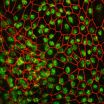(Press-News.org) Research led by a biology professor in the School of Science at Indiana University-Purdue University Indianapolis (IUPUI) has uncovered a method to produce retinal cells from regenerative human stem cells without the use of animal products, proteins or other foreign substances, which historically have limited the application of stem cells to treat disease and other human developmental disorders.
The study of human induced pluripotent stem cells (hiPSCs) has been pursued vigorously since they were first discovered in 2007 due to their ability to be manipulated into specific cell types. Scientists believe these cells hold considerable potential for cell replacement, disease modeling and pharmacological testing. However, clinical applications have been hindered by the fact that, to date, the cells have required animal products and proteins to grow and differentiate.
A research team led by Jason S. Meyer, Ph.D., assistant professor of biology, successfully differentiated hiPSCs in a lab environment—completely through chemical methods—to form neural retinal cell types (including photoreceptors and retinal ganglion cells). Tests have shown the cells function and grow just as efficiently as those cells produced through traditional methods.
"Not only were we able to develop these (hiPSC) cells into retinal cells, but we were able to do so in a system devoid of any animal cells and proteins," Meyer said. "Since these kinds of stem cells can be generated from a patient's own cells, there will be nothing the body will recognize as foreign."
In addition, this research should allow scientists to better reproduce these cells because they know exactly what components were included to spur growth and minimize or eliminate any variations, Meyer said. Furthermore, the cells function in a very similar fashion to human embryonic stem cells, but without controversial or immune rejection issues because they are derived from individual patients.
"This method could have a considerable impact on the treatment of retinal diseases such as age-related macular degeneration and forms of blindness with hereditary factors," Meyer said. "We hope this will help us understand what goes wrong when diseases arise and that we can use this method as platform for the development of new treatments or drug therapies."
"We're talking about bringing stem cells a significant step closer to clinical use," Meyer added.
Meyer, along with two graduate students, have worked for two years on this research with the help of an Indiana University Collaborative Research Grant and funding from the School of Science at IUPUI and the American Health Assistance Foundation.
The research will be published (http://www.science.iupui.edu) in the April edition of Stem Cells Translational Medicine. Co-authors include Akshayalakshmi Sridhar and Melissa M. Steward.
Meyer began researching hiPSCs while he was a post-doctoral research associate at the University of Wisconsin in Madison, where James Thomson, Ph.D., was one of two investigators to develop hiPSCs from adult cells in 2007. The other, Shinya Yamanaka, Ph.D, from Japan's Kyoto University, was awarded the Nobel Prize for Physiology or Medicine in 2012 for discovering the ability of mature cells to be reprogrammed into stem cells.
INFORMATION:
About the School of Science at IUPUI
The School of Science is committed to excellence in teaching, research and service in the biological, physical, behavioral and mathematical sciences. The School is dedicated to being a leading resource for interdisciplinary research and science education in support of Indiana's effort to expand and diversify its economy. For more information, visit http://www.science.iupui.edu
IUPUI stem cell research could expand clinical use of regenerative human cells
2013-03-20
ELSE PRESS RELEASES FROM THIS DATE:
Alloy developed at Sandia National Laboratories has potential for electronics in wells
2013-03-20
ALBUQUERQUE, N.M. — An alloy that may improve high-temperature electronics in oil and geothermal wells was really a solution in search of a problem.
Sandia National Laboratories first investigated the gold-silver-germanium alloy about 15 years ago as a possible bonding material in a new neutron tube product. But a design change forced Sandia to shelve the material, said Paul Vianco, who has worked in soldering and brazing technology at Sandia for 26 years.
Then a few years ago, researchers working on other projects with applications inside a well, referred to as downhole, ...
Los Alamos science sleuth on the trail of a Martian mystery
2013-03-20
THE WOODLANDS, Texas, March 19, 2013 — When it comes to examining the surface of rocks on Mars with a high-powered laser, five is a magic number for Los Alamos National Laboratory postdoctoral researcher Nina Lanza.
During a poster session today at the 44th Annual Lunar and Planetary Science Conference at The Woodlands, Texas, Lanza described how the laser-shooting ChemCam instrument aboard the Curiosity rover currently searching the surface of Mars for signs of habitability has shown what appears to be a common feature on the surface of some very different Martian rocks ...
Are accountable care organizations 'improving population health'?
2013-03-20
NEW YORK (March 19, 2013) -- Accountable Care Organizations (ACOs), a key feature of the Affordable Care Act (ACA), aim to control health care costs, enhance quality in health care and improve population health. But what does "improving population health" really mean? This is the question asked in a new viewpoint article by Weill Cornell Medical College researchers published in the March 20 issue of the Journal of the American Medical Association (JAMA). The authors argue a clear definition is crucial in order to formulate effective health care and social service policy.
Section ...
NASA's LRO sees GRAIL's explosive farewell
2013-03-20
VIDEO:
On Dec. 17, 2012, NASA's twin GRAIL spacecraft were deliberately crashed into the lunar surface traveling at nearly 4,000 mph. Another NASA spacecraft, Lunar Reconnaissance Orbiter, observed the impact using...
Click here for more information.
Many spacecraft just fade away, drifting silently through space after their mission is over, but not GRAIL. NASA's twin GRAIL (Gravity Recovery and Interior Laboratory) spacecraft went out in a blaze of glory Dec. 17, 2012, ...
Practice makes perfect with Webb telescope mirror placement
2013-03-20
VIDEO:
Engineers at the Goddard Space Flight Center test the robotic-like fixture that will place the primary mirror segments of the Webb Telescope onto the telescopes back plane.
Click here for more information.
NASA engineers and scientists have been making practice runs to ensure the placement of primary mirror segments on the James Webb Space Telescope go perfectly when the flight equipment is ready. NASA issued a video and photos showing the practice run in the giant ...
Abnormal stress response seen in toddlers exposed to meth in womb
2013-03-20
PISCATAWAY, NJ – Some 2-year-olds whose moms used methamphetamine during pregnancy may have an abnormal response to stressful situations, according to a study in the May issue of the Journal of Studies on Alcohol and Drugs.
Researchers saw the altered response in toddlers who were exposed to meth in the womb and who currently had signs of strife in their lives—such as a mom who drank heavily or had depression or other mental health symptoms. Specifically, the children's levels of the stress hormone cortisol did not rise as they should have during a tense situation (a ...
Atypical brain circuits may cause slower gaze shifting in infants who later develop autism
2013-03-20
CHAPEL HILL, N.C. – Infants at 7 months of age who go on to develop autism are slower to reorient their gaze and attention from one object to another when compared to 7-month-olds who do not develop autism, and this behavioral pattern is in part explained by atypical brain circuits.
Those are the findings of a new study led by University of North Carolina School of Medicine researchers and published online March 20 by the American Journal of Psychiatry.
"These findings suggest that 7-month-olds who go on to develop autism show subtle, yet overt, behavioral differences ...
Antidepressants for pregnant moms don't affect infants' growth
2013-03-20
CHICAGO --- Selective serotonin reuptake inhibitor (SSRI) antidepressants taken by a woman during pregnancy do not impact her infant's growth over the first year, reports a new study from a Northwestern Medicine scientist.
There had been concern that antidepressant treatment during pregnancy reduced growth during the first year. Previous data suggested depression during pregnancy also could diminish infant growth.
But the new study showed infants born to mothers who took SSRIs during pregnancy had a similar weight, length and head circumference over the first year ...
Researchers develop new anatomically based classification for diagnosing cervical spinal stenosis
2013-03-20
(CHICAGO) –Physician-researchers at the Rothman Institute at Jefferson have developed a new, clinically meaningful scale of severity for diagnosing patients with cervical spinal stenosis. Their goal was to create a more accurate scale than the current "mild, moderate or severe" designations used for patients with this condition, a narrowing of the spinal canal in the neck. Researchers sought to create a reproducible, clinically validated classification of central cervical stenosis.
The group will present their results on Wednesday, March 20th, at 12:18 pm, McCormick ...
Current and past smokers face greater risk for hip replacement failure
2013-03-20
CHICAGO – Smoking has been linked to prolonged healing time and greater risk for complications in orthopaedic and other surgeries, according to a new study presented today at the 2013 Annual Meeting of the American Academy of Orthopaedic Surgeons (AAOS).
Researchers reviewed records of all total hip replacement (THR, or total hip arthroplasty) patients between 2007 and 2009 to identify patients who used tobacco products at the time of surgery, or who smoked regularly prior to surgery.
There were 110 patients who regularly smoked, with a mean age of 55 and a mean follow ...




